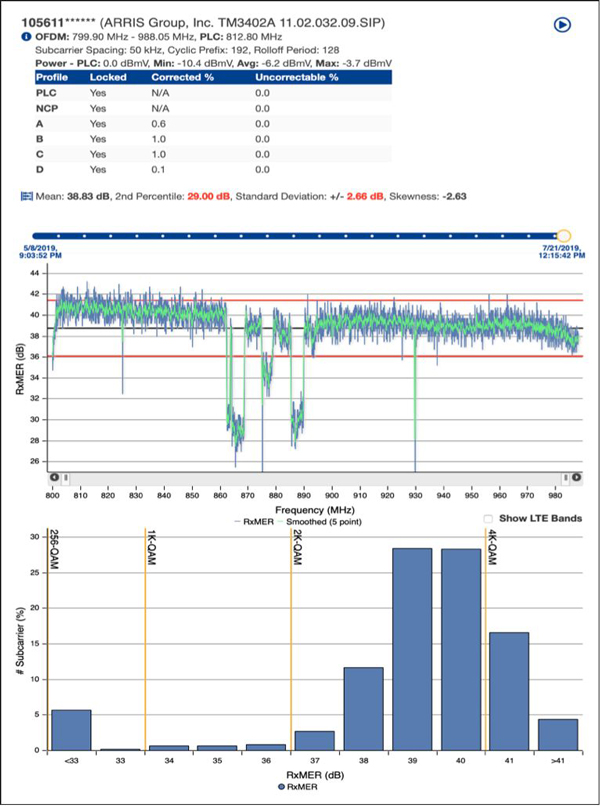How Good Is Your Gigabit Service?
AKLEZA INC. (Advertorial)
It seems like every day there is another press release announcing a new or expanded DOCSIS® 3.1 based gigabit service. Many operators have reported heavy interest from their subscriber base, looking for higher speed services to support the increasing number of devices and applications that they rely on each day. While the industry now has a lot of experience deploying and turning up DOCSIS 3.1 OFDM channels, variations in the physical cable plant can dramatically change the actual service being delivered — not just on a fiber node by fiber node basis, but even from one home to the next within a fiber node.
DOCSIS 3.1 has the ability to define multiple profiles that operate at different modulation orders. Additionally, a profile can define modulation orders to different sections of the OFDM channel to account for potential interference such as at the OFDM channel band edges. Depending upon the reported receive modulation error ratio (RxMER), the CMTS instructs the cable modem as to which profile to use to provide the highest speed, and yet at the same time have sufficient SNR margin for the cable modem to have an acceptable number of receive codeword errors. The CMTS periodically assesses and adjusts the recommended profile based on the reported RxMER values resulting in a potential variation in the available speed depending upon network conditions. While this dynamic adjustment of the delivered service makes the DOCSIS 3.1 services very resilient, it makes the task of monitoring service performance more critical as the actual delivered service may change over time.
Luckily the DOCSIS 3.1 specifications foresaw these requirements and included a set of PNM metrics that must be reported by cable modems and CMTSs that allow PNM tools to collect, analyze, and report on performance parameters. A detailed list of available metrics can be found in Section 9 of the DOCSIS 3.1 PHY specification. After analyzing data collected from production networks worldwide, it has become clear that tremendous insight into the performance of the OFDM channel serving a particular home or area of the network can be achieved using RxMER per subcarrier, FEC per profile summary data, and PLC and average power per 6 MHz measurements. All of these metrics are available from DOCSIS 3.1 cable modems, allowing a system wide view of how the cable plant is impacting a DOCSIS 3.1 service without having to drive around and take measurements using dedicated test equipment. Figure 1 shows an example of these measurements taken from a standard cable modem.

Figure 1: DOCSIS 3.1 CM metrics
Using these metrics, you can identify modems that are not able to sustain profiles with the highest modulation order and therefore potentially not able to achieve the service subscribed. Given that the OFDM channel is typically bonded with one or multiple SC-QAM channels, operating at a lower profile or even the complete loss of an OFDM channel may not be immediately noticed as Internet service is still available.
By correlating these measurements from different homes and at different times, it is possible to identify the potential location of cable plant faults that are impacting OFDM channels. For example, identifying homes where an RxMER per subcarrier plot shows a ripple or interference at certain frequencies as compared to other homes upstream, delineates the section of cable plant where a fault such as a bad connector, splice, cable crack, etc., must exist.
Actively monitoring how well your DOCSIS 3.1 service is operating may well eliminate subscriber complaints and improve subscriber satisfaction as they demand faster and faster speeds from their service.
To see a demonstration of Akleza’s comprehensive set of PNM products including our DOCSIS 3.1 monitoring product, CableDiag31, visit us at SCTE•ISBE Cable-Tec Expo, contact sales@akleza.com, or call 1-855-4-AKLEZA.
 James Medlock
James Medlock
Founder & CEO
Akleza, Inc.
James is the Founder and CEO of Akleza, and a cable industry veteran contributing to various CableLabs and industry specifications including DOCSIS, PacketCable Multimedia, IMS, and PNM. Having been involved in the original CableLabs PNM working group development, he founded Akleza with a mission to deliver easy to use, software based, diagnostic tools leveraging the availability of PNM data within the cable network.
1-855-4-AKLEZA



